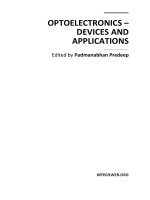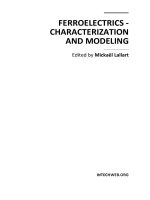Behaviour of Electromagnetic Waves in Different Media and Structures Part 1 pdf
Bạn đang xem bản rút gọn của tài liệu. Xem và tải ngay bản đầy đủ của tài liệu tại đây (644.73 KB, 30 trang )
BEHAVIOUR OF
ELECTROMAGNETIC WAVES
IN DIFFERENT MEDIA AND
STRUCTURES
Edited by Ali Akdagli
Behaviour of Electromagnetic Waves in Different Media and Structures
Edited by Ali Akdagli
Published by InTech
Janeza Trdine 9, 51000 Rijeka, Croatia
Copyright © 2011 InTech
All chapters are Open Access articles distributed under the Creative Commons
Non Commercial Share Alike Attribution 3.0 license, which permits to copy,
distribute, transmit, and adapt the work in any medium, so long as the original
work is properly cited. After this work has been published by InTech, authors
have the right to republish it, in whole or part, in any publication of which they
are the author, and to make other personal use of the work. Any republication,
referencing or personal use of the work must explicitly identify the original source.
Statements and opinions expressed in the chapters are these of the individual contributors
and not necessarily those of the editors or publisher. No responsibility is accepted
for the accuracy of information contained in the published articles. The publisher
assumes no responsibility for any damage or injury to persons or property arising out
of the use of any materials, instructions, methods or ideas contained in the book.
Publishing Process Manager Iva Lipović
Technical Editor Teodora Smiljanic
Cover Designer Jan Hyrat
Image Copyright Ivanagott, 2010. Used under license from Shutterstock.com
First published June, 2011
Printed in Croatia
A free online edition of this book is available at www.intechopen.com
Additional hard copies can be obtained from
Behaviour of Electromagnetic Waves in Different Media and Structures,
Edited by Ali Akdagli
p. cm.
ISBN 978-953-307-302-6
Contents
Preface IX
Chapter 1 Electric and Magnetic Characterization of Materials 1
Leonardo Sandrolini, Ugo Reggiani and Marcello Artioli
Chapter 2 Features of Electromagnetic Waves Scattering by
Surface Fractal Structures 17
O. Yu. Semchuk and M. Willander
Chapter 3 Electromagnetic Wave Scattering from Material Objects
Using Hybrid Methods 27
Adam Kusiek, Rafal Lech and Jerzy Mazur
Chapter 4 The Eigen Theory of Electromagnetic Waves
in Complex Media 53
Shaohua Guo
Chapter 5 Electromagnetic Waves in Cavity Design 77
Hyoung Suk Kim
Chapter 6 Wide-band Rock and Ore Samples
Complex Permittivity Measurement 101
Sixin Liu, Junjun Wu, Lili Zhang and Hang Dong
Chapter 7 Detection of Delamination in Wall Paintings
by Ground Penetrating Radar 121
Wanfu Wang
Chapter 8 Interaction of Electromagnetic
Radiation with Substance 141
Andrey N. Volobuev
Chapter 9 Ultrafast Electromagnetic Waves
Emitted from Semiconductor 161
YiMing Zhu and SongLin Zhuang
VI Contents
Chapter 10 Electromagnetic Wave Propagation
in Ionospheric Plasma 189
Ali Yeşil and İbrahim Ünal
Chapter 11 Exposing to EMF 213
Mahmoud Moghavvemi, Farhang Alijani, Hossein Ameri Mahabadi
and Maryam Ashayer Soltani
Chapter 12 Low Frequency Electromagnetic Waves Observation
During Magnetotail Reconnection Event 237
X. H. Wei, J. B. Cao and G. C. Zhou
Chapter 13 Solitary Electromagnetic Waves
Generated by the Switching Mode Circuit 249
Hirokazu Tohya and Noritaka Toya
Chapter 14 Effect of Magnetic Field on Nonlinear Absorption
of a Strong Electromagnetic Wave
in Low-dimensional Systems 275
Nguyen Quang Bau, Le Thai Hung and Hoang Dinh Trien
Chapter 15 Chiral Transverse Electromagnetic Standing Waves with
EH in the Dirac Equation and the Spectra
of the Hydrogen Atom 301
H. Torres-Silva
Chapter 16 Electromagnetic Response of Extraordinary Transmission
Plates Inspired on Babinet’s Principle 325
Miguel Navarro-Cía, Miguel Beruete and Mario Sorolla
Chapter 17 The Influence of Vacuum Electromagnetic
Fluctuations on the motion of Charged Particles 353
Guozhong Wang
Chapter 18 Observation of Cavity Interface and Mechanical Stress in
Opaque Material by THz Wave 383
Tsuguhiro Takahashi
Chapter 19 Reciprocity in Nonlocal Optics and Spectroscopy 399
Huai-Yi Xie
Chapter 20 Focused Arrays Beamforming 419
Oleksandr Mazurenko and Yevhenii Yakornov
Preface
Lately, there has been a growing interest in electromagnetic wave propagation in
complex systems such as modern materials and structures. This book is intended to
give the explanatory 20 chapters which consist of original works of the leading scien-
tists in the field of wave propagation which produced theoretical and experimental
methods in this field of research and obtained important results.
In chapter 1, the possible procedures for the extraction of electric and magnetic para-
meters of dispersive materials were outlined, and it was shown that the complex rela-
tive permittivity and magnetic permeability can be modeled with either dispersive
laws or on a point-by-point basis (at individual frequencies).
In the frame of the Kirchhoff method, the average coefficient of light scattering by sur-
face fractal structures was calculated in chapter 2. A normalized band-limited Weier-
strass function was presented for modeling 2D fractal rough surfaces. On the basis of
numerical calculation of average scattering coefficient the scattering indicatrises dia-
grams for various surfaces and falling angles were calculated.
As it is well known the method of moments and finite difference method are widely
used as electromagnetic numerical techniques. In the chapter 3, depending on the in-
vestigated post geometry, a hybrid method which utilities mode-matching technique,
method of moments and finite difference method defined in the frequency domain
was proposed for electromagnetic wave scattering from structures containing complex
cylindrical or spherical objects.
The standard spaces were constructed under the physical presentation by solving the
eigen-value problem of the matrixes of dielectric permittivity and magnetic permeabil-
ity in chapter 4. Based on the spaces, it was discussed the modal equations of electro-
magnetic waves for anisotropic media, bi-anisotropic media, dispersive medium and
chiral medium, respectively, by converting the classical Maxwell’s vector equation to
the eigen Maxwell’s scalar equation, each of which shows the existence of an electro-
magnetic sub-wave, and its propagation velocity, propagation direction, polarization
direction and space pattern were completely determined in the equations.
In chapter 5, some electromagnetic wave equations to show applications to develop
the analytic design formula for the cavity design were presented. Several examples for
X Preface
the rectangular cavity was introduced for atmospheric microwave plasma torch as a
rectangular, which has uniform electromagnetic wave distribution to produce wide
area plasma in atmospheric pressure environment. The annular cavity for klystrode
was introduced for a microwave vacuum oscillator as a circular example, which
adapted the grid structure and the electron beam as an annular shape, gives high effi-
ciency compared with conventional klystrode.
Ground penetrating radar (GPR) is based on high-frequency electromagnetic wave
propagation and its detecting targets are below the ground surface. In order to under-
stand the performance of GPR, permittivity testing and analysis are critical. In chapter
6, permittivity analysis and measurement methods for rock sample were given for
GPR applications.
Focusing on the propagation of high frequency pulse electromagnetic waves in layered
lossy and dispersive medium and after the physical forward modeling experiment, in
chapter 7, the delamination in polished wall paintings by wall coupling antennas us-
ing GPR was explained. It was shown that the ultra-wide band GPR is capable of de-
tecting delamination in vertical resolution of about 5 mm when it is equipped with a
transmitting antenna of 1.6 GHz central frequency.
With the help of Maxwell’s equations, the laws of formation of the impulse of electro-
magnetic radiation in dielectric environment for conditions self-induced transparency
were considered in chapter 8.
In chapter 9, ultrafast electromagnetic waves emitted from semiconductors under high
electric fields, which are closely related with ultrafast nonequilibrium transport of car-
riers in semiconductor, were investigated.
The behavior of electromagnetic waves emitted from within the ionospheric plasma
and the analytical solutions which are necessary to understand the characteristics of
the environment were explained in chapter 10. Problems in plasma physics at the con-
ductivity, dielectric constants and refractive index were defined according to the me-
dia parameters.
In the recent years, by developing the usage of new popular electronic-communication
gadgets and home appliances like mobile phones and microwave ovens which are
mostly sources of electromagnetic wave radiation, a severe public concern regarding
the side-effects whether positive or negative on human health and environment has
arisen. In chapter 11, the different types of electromagnetic field and their characteris-
tics besides of definitions were introduced and investigated separately. The biologic
effects on live tissues and human body were also investigated for concerned fields.
Magnetic reconnection is a very important physical process in astrophysical and la-
boratory plasmas, which enables reconfiguration of the magnetic field topology and
converts the magnetic field energy to plasma kinetic and thermal energy. The diffusion
region is a crucial region of reconnection where magnetic field and plasma decouple
Preface XI
from each other and strong wave activity and complex wave particle interactions oc-
cur. In chapter 12, observations of low frequency electromagnetic waves where recon-
nection signatures are well defined as well as those observations where one only spe-
culates about such relationship were summarized.
The switching mode circuit (SMC) is being applied widely to the power circuit and the
signal circuit including the digital circuit now. The SMC works by the transistor or the
other switching devices. The SEMW theory was developed for the design and analysis
of the traces and interconnects on the SMC. The SEMW theory and its application ex-
amples of the analysis of the signal line and the power line on the system on a chip
were presented in chapter 13.
In chapter 14, the nonlinear absorption of a strong electromagnetic wave by confined
electrons in low-dimensional systems in the presence of an external magnetic field was
investigated. By using the method of the quantum kinetic equation for electrons, the
expressions for the electron distribution function and the nonlinear absorption coeffi-
cient in quantum wells, doped superlattics, cylindrical quantum under the influence of
an external magnetic field were obtained.
The conditions under which transverse electromagnetic (TEM) waves exist in a source-
less medium was examined in chapter 15. It was shown that TEM waves could be clas-
sified according to whether their Poynting vector is identically zero or nonzero.
Lorentz-Dirac equation (LDE) is the widely accepted classical equation to describe the
motion of a scalar point charge acted by external electromagnetic fields and its own
radiating fields. A new reduction of order form of LDE, which coincides with that ob-
tained by the method of Landau and Lifshitz in its Taylor series form was presented in
chapter 16.
In chapter 17, the polarization effects arisen from perforated metallic plates exhibiting
extraordinary transmission were given. Setting aside the state-of-the-art of perforated
metallic plates, it was shown that by applying Babinet’s principle, subwavelength hole
arrays arranged in rectangular lattice can further enhance its potential polarization re-
sponse.
THz wave technology is remarkable in recent optical engineering area. Many devel-
opment and application researches are being carried out. In chapter 18, one of such re-
searches, study of internal measurement application for insulating materials, was re-
viewed. Some measurements were carried out with polyethylene, in which THz wave
shows high transmission probability, and internal cavity interface and mechanical
stress was detected. The applicability of such internal measurement in polyethylene
was presented.
In chapter 19, the aim was to construct the conditions for optical reciprocity in the case
with a nonlocal anisotropic magnetic permeability and electric permittivity, motivated
XII Preface
by the recent explosion in the research with metamaterials according to two different
mathematical viewpoints.
Finally, in the last chapter, beamforming of antenna arrays focused in near field zone
or intermediate-field zone was studied and new principles of this process were re-
vealed with a purpose of increasing the 3-dimensional gain performance of antenna
arrays at a wide range of angles and improving the quality level of this technique for
expanding applicability of the focused antenna.
I hope interested readers have the possibility for finding the important and fundamen-
tal results on electromagnetic wave propagation in media that exhibits different elec-
trical and magnetic properties.
I thank to Mr. Željko Špalj and Msc. Iva Lipovic who helped me. I would also like to
thank to Prof. Dr. Kerim GUNEY who had a lot of support for my scientific develop-
ment.
Ali Akdagli
Electrical and Electronics Dept., Mersin University
Turkey
0
Electric and Magnetic Characterization
of Materials
Leonardo Sandrolini, Ugo Reggiani and Marcello Artioli
Department of Electrical Engineering, University of Bologna
Italy
1. Introduction
The knowledge of the electric and magnetic properties of materials over a broadband
frequency range is an essential requirement for accurate modelling and design in
several engineering applications. Such applications span printed circuit board design,
electromagnetic shielding, biomedical research and determination of EM radiation hazards
(Deshpande et al. (1997); Li et al. (2011); Murata et al. (2005)). The electric and magnetic
properties of materials usually depend on several factors: frequency, temperature, linearity,
isotropy, homogeneity, and so on. The dispersive behaviour exhibited by these materials can
be represented by a complex relative permittivity and magnetic permeability which depend
on frequency as
ˆ
ε
(ω)=ε
(ω) − jε
(ω) (1)
ˆ
μ
(ω)=μ
(ω) − jμ
(ω) (2)
being ω the angular frequency, ε
, μ
the real parts and ε
, μ
the imaginary parts of
the complex relative permittivity and magnetic permeability, respectively. The real part
takes the ability of the medium to store electrical (or magnetic) energy into account, the
imaginary part the dielectric (or magnetic) energy losses. The interaction of incident
electromagnetic fields with a material can be successfully investigated only when accurate
information on the complex permittivity and magnetic permeability is attained. For example,
from the knowledge of the frequency dependence of the complex relative permittivity and
magnetic permeability of a material, the shielding effectiveness of a structure made of that
material can be predicted; similarly, signal interconnects can be accurately designed when
the frequency dependence of the dielectric substrate is known; from dielectric property
information of tissues the spatial distribution of an incident electromagnetic field and the
absorbed power can be accurately determined. Although the complex relative permittivity
and magnetic permeability are quantities not directly measurable, they are reconstructed
from the measurement of a sensor reflection coefficient or scattering parameters, which can
be obtained with a number of different techniques proposed and developed over the last
decades (Afsar et al. (1986); Baker-Jarvis et al. (1995); Faircloth et al. (2006); Ghodgaonkar
et al. (1990); Queffelec et al. (1994)). Some of these techniques are: open-ended coaxial
probe, free-space measurement, cavity resonator, parallel plate capacitor, transmission-line
techniques (microstrip, waveguide, etc.); they may be in time domain or frequency domain
and make use of probes with one or two ports. No technique is all-embracing as each
1
2 Will-be-set-by-IN-TECH
is limited by its own constraint to specific frequencies, materials (e.g., liquid, malleable
or solid material; isotropic or anisotropic) and applications. Regardless of the technique
used for the measurement, the common challenge is the extraction of the complex relative
permittivity and/or magnetic permeability from measured data by expressing the measured
quantities as a function of these parameters. The inversion problem to be solved is thus
affected by the mathematical model, i.e., the theoretical expressions that relate the electrical
and/or magnetic parameters to the measured quantities. The inversion problem can be
solved with deterministic or stochastic methods. The complex relative permittivity and
magnetic permeability can be determined over the whole frequency range of interest or on
a point-by-point basis (at individual frequency points). It is assumed that the materials
considered in the analysis present a negligible ohmic conductivity (σ
= 0). The chapter
is organized as follows. Section 2 of the chapter will briefly cover the most common
experimental methods used in the electric and magnetic characterization of materials. The
problem formulation is presented in Section 3 and the outline of a proposed procedure
for parameter extraction is given in Section 4. Finally, results obtained with the proposed
approach are shown and commented in Section 5.
2. Techniques of measurement
There exist a large number of techniques developed for the measurement of the electric and
magnetic properties of materials. The most common and widespread one- and two-port
techniques are transmission-line techniques (open-ended coaxial probe (Misra et al. (1990); Xu
et al. (1991)), rectangular (Deshpande et al. (1997); Faircloth et al. (2006); Jarem et al. (1995))
or cylindrical (Ligthart (1983)) waveguide, microstrip or stripline (Barry (1986); Queffelec et
al. (1994))), free-space measurement (Galek et al. (2010); Ghodgaonkar et al. (1990)) and cavity
resonator (Yoshikawa and Nakayama (2008)). These techniques are different for accuracy and
frequency bandwidth of measurement; some are nondestructive and noncontacting and may
require sample preparation. Measurement results can also be different because of the field
orientation with respect to the material interface, being the measurement more accurate when
the fields are tangential to the interface. Although resonator techniques are recognized as
more accurate than transmission-line techniques, they can be applied in a narrow frequency
band only. In the next sections an overview of the most common broadband techniques of
measurement is given.
2.1 One-port techniques
2.1.1 Open-ended coaxial probe
Open-ended coaxial probes have been used extensively by a number of authors mainly for
measuring the complex permittivity of dispersive materials (Misra et al. (1990); Stuchly et
al. (Febr. 1994); Xu et al. (1991)). For instance, they have been used to measure the electric
properties of biological tissues, soils, food, chemicals. The open end of the probe is put in
contact with a specimen of the material and the complex reflection coefficient at the aperture
is measured with a vector network analyzer (VNA). The technique is particularly suitable for
liquids or malleable solids that make a good contact with the probe face. The measurement of
solid materials may be affected by a significant error if there are air gaps between the face of
the probe and the sample due to surface roughness of the sample. In fact, the electric field at
the probe aperture has both the radial and axial components. Models which keep the lift-off
of the probe into account have also been proposed (Baker-Jarvis et al. (1994)). Basically, the
technique consists in retrieving the complex permittivity from the measurement by relating
2
Behaviour of Electromagnetic Waves in Different Media and Structures
Electric and Magnetic Characterization
of Materials 3
it to the coaxial probe aperture admittance which, in turn, is obtained from the measured
reflection coefficient. The probe is designed in order to have only the TEM mode propagating
along the coaxial line, therefore the upper limit of the frequency range in which this fixture
can be employed is determined by the frequency cutoff of the higher order modes created at
the discontinuity introduced by the material under test. This cutoff frequency depends on the
inner and outer diameters of the probe. Moreover, the cell must be long enough to make the
evanescent modes decay appreciably far from the open end of the probe. Another issue of
this technique concerns the probe calibration, which is usually carried out in three steps with
factory-standard calibration loads (short, open and load terminations) (Blackham and Pollard
(1997)). In order to improve the accuracy of the measurement, reference loads with liquids
of known permittivity (Marsland and Evans (1987)) or short-cavitiy terminations (Otto and
Chew (1991)) have been proposed.
2.2 Two-port techniques
2.2.1 Waveguide
The technique consists in filling completely or in part the cross-section of a waveguide (or
TEM transmission line) with a material sample and in measuring the scattering parameters by
means of a VNA in a broadband frequency range. The electric and magnetic parameters of the
material are found through the discontinuity introduced by the sample inside the waveguide
as the scattering parameters are related to the permittivity and magnetic permeability of the
material with the scattering equations (Nicolson and Ross (1970)). Although preparation is
simple, the sample needs to be machined to be fit into the fixture. The most common geometry
for the waveguides is the rectangular one; in particular, the waveguide is designed to have
only the dominant mode TE
10
in order to avoid exciting higher order modes.
2.2.2 Free-space measurement
The technique consists in measuring the insertion loss and phase change of a material sample
by means of a couple of antennas. The measurement is carried out in free space in a wide
broadband frequency range, which extends from a few tens of MHz to tens of GHz according
to the available instrumentation. As the technique is contactless and nondestructing, it can
be suitable to high-temperature measurements (Ghodgaonkar et al. (1990)). The two antennas
are connected to the two ports of a VNA and the scattering parameters related to transmitted
and reflected fields are measured. The permittivity and magnetic permeability of the material
are then calculated through the scattering equations.
3. Problem formulation
The extraction of the electric and/or magnetic parameters of materials from measurement is a
two-step process. The first step of this inversion problem is to find a mathematical model that
relates the electrical and/or magnetic parameters of the material under test to the measured
quantities.
3.1 Open-ended coaxial probe formulation
For the open-ended coaxial probe measurement technique the complex relative permittivity
is determined by inverting the expression of
ˆ
Y
(
ˆ
ε
), where
ˆ
Y is the aperture admittance of the
probe (Stuchly et al. (Febr. 1994))
ˆ
Y
= Y
0
1 −
ˆ
Γ
1 +
ˆ
Γ
(3)
3
Electric and Magnetic Characterization of Materials
4 Will-be-set-by-IN-TECH
where Y
0
is the characteristic admittance of the coaxial line and
ˆ
Γ is the reflection coefficient
at the aperture. There are several analytical expressions for the aperture admittance of
open-ended coaxial probes (De Langhe et al. (1993); Misra et al. (1990); Xu et al. (1987; 1991))
which contain the complex permittivity explicitly and that can be compared to the measured
admittance. Some are very heavy from the computational point of view and may result in
convergence problems when numerically solved, because of the presence of multiple integrals,
Bessel functions and sine integrals. The expression for the aperture admittance given by
(Marcuvitz (1951)), found by matching the electromagnetic field around the probe aperture,
can be adopted
ˆ
Y
=
√
ˆ
εY
0
√
ε
cl
ln
(
b/a
)
ˆ
π/2
0
J
0
γ
0
a
√
ˆ
ε sin θ
− J
0
γ
0
b
√
ˆ
ε sin θ
2
dθ
sin θ
+
j
π
ˆ
π
0
⎡
⎣
2Si
⎛
⎝
γ
0
a
√
ˆ
ε
1 +
b
2
a
2
−2
b
a
cos θ
⎞
⎠
−Si
2γ
0
a
√
ˆ
ε sin
θ
2
−Si
2γ
0
b
√
ˆ
ε sin
θ
2
dθ
(4)
where:
ˆ
ε is the complex relative permittivity of the material under test, ε
cl
is the relative
permittivity of the coaxial line, a and b are the inner and outer radii of the coaxial line,
respectively, γ
0
is the absolute value of the propagation constant in free space (see (16)), Si
and J
0
are the sine integral and the Bessel function of zero order, respectively. This integral
expression can be evaluated numerically by means either of series expansion as in (Misra et
al. (1990); Xu et al. (1987)) or numerical integration.
3.2 Two-port formulation
In a similar manner, for two-port techniques the theoretical expressions of the scattering
parameters as functions of the complex relative permittivity (1) and magnetic permeability
(2) have to be found. This can be easily achieved expressing the scattering parameters
ˆ
S
11
(ω) and
ˆ
S
21
(ω), which can be measured with a VNA and with a two-port fixture, as a
function of the reflection coefficient of the air-sample interface and transmission coefficient,
ˆ
Γ and
ˆ
T, respectively. For the TEM propagation mode (free-space measurement system
and TEM transmission line) and for waveguides with only the TE
10
propagation mode
these expressions for S
11
and S
21
are (Barroso and De Paula (2010); Boughriet et al. (1997);
Ghodgaonkar et al. (1990); Ligthart (1983))
ˆ
S
11
=
ˆ
Γ
1
−
ˆ
T
2
1 −
ˆ
Γ
2
ˆ
T
2
, (5)
ˆ
S
21
=
ˆ
T
1
−
ˆ
Γ
2
1 −
ˆ
Γ
2
ˆ
T
2
(6)
being
ˆ
Γ
=
ˆ
Z
− Z
0
ˆ
Z
+ Z
0
, (7)
ˆ
T
= e
−
ˆ
γd
(8)
4
Behaviour of Electromagnetic Waves in Different Media and Structures
Electric and Magnetic Characterization
of Materials 5
and for a rectangular waveguide (Inan and Inan (2000); Kraus and Fleisch (1999); Sadiku
(2007))
ˆ
Z
= j
ωμ
0
ˆ
μ
ˆ
γ
, (9)
Z
0
= j
ωμ
0
ˆ
γ
0
, (10)
ˆ
γ
= j
2π
λ
0
ˆ
ε
ˆ
μ
−
λ
0
λ
0c
2
, (11)
ˆ
γ
0
= j
2π
λ
0
1 −
λ
0
λ
0c
2
(12)
where
ˆ
Z and
ˆ
γ are the intrinsic impedance and propagation constant of the filled waveguide,
respectively, Z
0
and
ˆ
γ
0
are the intrinsic impedance and propagation constant of the empty
waveguide, respectively, and d is the thickness of the sample. The propagation constants
depend on the wavelength in free space λ
0
and the cutoff wavelength in the waveguide λ
0c
(i.e., the wavelength in free space at the cutoff frequency in the empty waveguide (Kraus and
Fleisch (1999))). For a rectangular waveguide λ
0c
= 2a, where the width of the waveguide a
is chosen to be twice the height of the waveguide in order to have only the TE
10
propagation
mode impinging on the material sample in the frequency range of interest.
For free space-measurement, (9)-(12) become (Galek et al. (2010); Ghodgaonkar et al. (1990))
ˆ
Z
= Z
0
ˆ
μ
ˆ
ε
, (13)
Z
0
=
μ
0
ε
0
, (14)
ˆ
γ
=
ˆ
γ
0
ˆ
ε
ˆ
μ, (15)
ˆ
γ
0
= j
2π
λ
0
(16)
where
ˆ
Z and Z
0
are the intrinsic impedances of the material under test and free space,
respectively.
Once the scattering parameters (5) and (6) are expressed as functions of
ˆ
ε and
ˆ
μ, they must be
inverted to yield the complex relative permittivity and magnetic permeability.
4. Procedure for the extraction
The second step of the inversion problem is the extraction of the material parameters from the
measured quantities.
4.1 Nicolson-Ross-Weir procedure
In the standard Nicolson-Ross-Weir procedure (Nicolson and Ross (1970); Weir (1974)),
the relative complex permittivity and magnetic permeability are obtained explicitly for a
rectangular waveguide from (7) to (12) on a point-by-point basis as
ˆ
μ
=
λ
0g
ˆ
Λ
1
+
ˆ
Γ
1 −
ˆ
Γ
, (17)
5
Electric and Magnetic Characterization of Materials
6 Will-be-set-by-IN-TECH
ˆ
ε
=
λ
2
0
ˆ
μ
1
ˆ
Λ
2
+
1
λ
2
0c
(18)
where λ
0g
is the wavelength in the empty waveguide
λ
0g
=
λ
0
1 −
(
λ
0
/λ
0c
)
2
(19)
and
1
ˆ
Λ
2
= −
1
2πd
ln
1
ˆ
T
2
. (20)
This requires to express
ˆ
Γ and
ˆ
T from the measured scattering parameters
ˆ
S
11
and
ˆ
S
21
:from
(5) and (6) one can write
ˆ
K
=
ˆ
S
2
11
−
ˆ
S
2
21
+ 1
2
ˆ
S
11
(21)
ˆ
Γ
=
ˆ
K
±
ˆ
K
2
−1 (22)
ˆ
T
=
ˆ
S
11
+
ˆ
S
21
−
ˆ
Γ
1 −
ˆ
S
11
+
ˆ
S
21
ˆ
Γ
. (23)
However, this procedure presents phase ambiguity and suffers instability at frequencies
where the sample length is a multiple of one-half wavelength in low-loss materials. To
overcome this problem, in (Baker-Jarvis et al. (1990)) an iterative procedure has been
proposed, which gives stable solutions over the frequency range. This technique requires
setting the relative magnetic permeability to 1 and a good initial guess for the permittivity
(usually a solution of the Nicolson-Ross equations).
4.2 Fitting procedure
A different procedure for the extraction of material parameters involves minimizing the
distance between the calculated aperture admittance (4) or scattering parameters (5) and
(6) and the corresponding measured quantities through fitting algorithms, which may be
based either on deterministic or stochastic optimization procedures. The minimization can
be carried out over the whole frequency range or on a point-by-point basis (i.e., at individual
frequency points).
The former approach, followed by a number of authors, consists in modelling the complex
relative permittivity and magnetic permeability with a prespecified functional form whose
parameters needs to be determined with an optimization procedure. Laurent series can
be used for complex relative permittivity and magnetic permeability models (Domich et al.
(1991)), as well as dispersive laws, such as Havriliak-Negami and its special cases Cole-Cole
and Debye to model dielectric relaxation (Kelley et al. (2007)), or the Lorentz model for both
dielectric and magnetic dispersion (Koledintseva et al. (2002)). The Havriliak-Negami model
is an empirical modification of the single-pole Debye relaxation model
ˆ
ε
(ω)=ε
∞
+
ε
s
−ε
∞
1
+(jωτ)
1−α
β
(24)
where ε
s
and ε
∞
are the values of the real part of the complex relative permittivity at low and
high frequency, respectively, τ is the relaxation time, and α and β are positive real constants
6
Behaviour of Electromagnetic Waves in Different Media and Structures
Electric and Magnetic Characterization
of Materials 7
(
0 ≤ α, β ≤ 1
)
. From this model, the Cole-Cole equation can be derived setting β = 1; the
Debye equation is obtained with α
= 0 and β = 1. This empirical model has the ability to
give a better fit to the behaviour of dispersive materials over a wide frequency range. When
multiple relaxation times are needed, the complex relative permittivity can be modelled with
a Debye function expansion
ˆ
ε
(ω)=ε
∞
+
N
∑
n=1
Δε
n
1 + jωτ
n
(25)
being Δε
n
and τ
n
for n = 1, 2, . . . , N the strengths and relaxation times of the Debye dispersion,
respectively. Modelling the complex relative permittivity with the Lorentz model yields
ˆ
ε
(ω)=ε
∞
+
(
ε
s
−ε
∞
)
ω
2
0
ω
2
0
+ jωδ − ω
2
(26)
where ω
0
is the resonance frequency and δ is the damping factor. For instance, for open-ended
coaxial probe measurements of complex relative permittivity, introducing (24) into (4) we
obtain an aperture admittance which depends then on five parameters
ˆ
Y
(
ε
s
, ε
∞
, τ, α, β
)
(27)
which reduce to four in the case of the Cole-Cole model
ˆ
Y
(
ε
s
, ε
∞
, τ, α
)
(28)
and to three for the Debye model
ˆ
Y
(
ε
s
, ε
∞
, τ
)
. (29)
For the Debye function expansion, the aperture admittance depends on 2N
+ 1 parameters
ˆ
Y
(
Δε
1
, ,Δε
N
, ε
∞
, τ
1
, ,τ
N
)
. (30)
Eventually, for the Lorentz model, the aperture admittance is
ˆ
Y
(
ε
s
, ε
∞
, ω
0
, δ
)
. (31)
With reference to the above listed models (24)-(26) for the dispersion law, this approach is
summarized in Fig. 1. The unknown parameters are then extracted by fitting the expressions
from (27) to (31) to the measured characteristic data.
It can be observed that this approach can also be applied to measurement techniques of
the complex permittivity other than open-ended coaxial probes, provided that the analytical
relation between a measurable quantity and the complex permittivity is known. In a
similar manner, it can be applied to the simultaneous extraction of the complex permittivity
and magnetic permeability of a material by comparing the analytical reflection (
ˆ
S
11
) and
transmission (
ˆ
S
21
) coefficients to the measurements carried out with a VNA in the standard
transmission-line or free-space techniques.
The success of the extraction of the model parameters relies on a proper choice of the
dispersive laws for the material under test; conversely, the fitting algorithms may experience
nonconvergence issues or the parameters of the models may be determined with excessive
errors. Especially for newly developed materials, individuating the proper dispersion laws
may result in a difficult task. Moreover, the complexity of the models affects also the choice of
the fitting algorithm for the parameter extraction.
7
Electric and Magnetic Characterization of Materials
8 Will-be-set-by-IN-TECH
ˆε(ω)=ε
∞
+
ε
s
− ε
∞
1+(jωτ)
1−α
ˆε(ω)=ε
∞
+
ε
s
− ε
∞
[1 + (jωτ)
1−α
]
β
ˆε(ω)=ε
∞
+
ε
s
− ε
∞
1+jωτ
ˆε(ω)=ε
∞
+
N
n=1
Δε
n
1+jωτ
n
ˆε(ω)=ε
∞
+
(ε
s
− ε
∞
) ω
2
0
ω
2
0
+ jωδ − ω
2
ˆ
Y (ε
s
,ε
∞
,ω
0
,δ)
ˆ
Y (Δε
1
, , Δε
N
,ε
∞
,τ
1
, , τ
N
)
ˆ
Y (ε
s
,ε
∞
,τ,α)
ˆ
Y (ε
s
,ε
∞
,τ)
ˆ
Y (ε
s
,ε
∞
,τ,α,β)
ˆ
Y =
ˆ
Y (ˆε)
Fig. 1. Aperture admittance of an open-ended coaxial probe as a function of dispersion law
parameters.
For these reasons, the latter approach can be followed, which consists in not making any
assumption on the dispersive laws and in determining the real and imaginary parts of the
material complex parameters at each measurement frequency (on a point-by-point basis).
Once the complex relative permittivity and magnetic permeability as a function of frequency
are known, proper models can be chosen to represent the material properties over the entire
frequency range of measurement. For example, for isotropic materials which exhibit electric
and magnetic properties, the inversion process involves the minimization of an objective
function ϕ of the kind
ϕ
f
i
, ε
, ε
, μ
, μ
=
N
∑
i=1
ˆ
S
11measured
(
f
i
)
−
ˆ
S
11calculated
f
i
, ε
, ε
, μ
, μ
2
+
ˆ
S
21measured
(
f
i
)
−
ˆ
S
21calculated
f
i
, ε
, ε
, μ
, μ
2
(32)
where f
i
is the generic frequency of the N frequencies of the measurement data set. The
reflection and transmission coefficients
ˆ
S
11
and
ˆ
S
21
are those of a two-port technique of
Sec. 2. Similarly, when the open-ended coaxial probe is used, the determination of the
complex permittivity requires to minimize an objective function ψ at each frequency of the
measurement data set
ψ
f
i
, ε
, ε
=
N
∑
i=1
ˆ
Y
measured
(
f
i
)
−
ˆ
Y
calculated
f
i
, ε
, ε
2
. (33)
8
Behaviour of Electromagnetic Waves in Different Media and Structures
Electric and Magnetic Characterization
of Materials 9
This approach is handled with the proposed procedure, where a number of optimization
algorithms are used to search the minimum values and to overcome possible convergence
issues or local minima stalemates. They can be deterministic (e.g., Newton, Interior Point,
Quasi-Newton, Levenberg-Marquardt, Gradient, Nonlinear Conjugate Gradient, Principal
Axis, Nelder-Mead) or stochastic (e.g., Differential Evolution, Simulated Annealing, Random
Search, Particle Swarm). This choice is also motivated as different optimization methods
may result in being more appropriate to extract the complex relative permittivity and/or
magnetic permeability of the same material at different measurement frequencies. For each
measurement frequency, the optimization methods are applied according to a user defined
sequence. In case an optimization method does not reach convergence or the desired
accuracy within the maximum number of iterations, the minimum search is repeated with
the next optimization method in the sequence. The proposed procedure, summarized in the
flow-chart of Fig. 2, was implemented in Mathematica (Wolfram Research, Inc. (2008)), a
powerful and complex programming environment with the capability of performing both
numerical and symbolic calculations. This computational language can be easily extended
developing custom algorithms. The optimization methods employed in the parameter
extraction procedure are listed in Table 1; of course, other optimization algorithms may be
added to this sequence, thus increasing the chances of determining the complex relative
permittivity with the requested accuracy. The worst result is given by the failure of all
optimization methods.
The interesting aspect of this approach is that the determination of the complex relative
permittivity and magnetic permeability may be enhanced with subsequent refinements;
more experimental points measured at different frequencies can be added to the first set of
measurement data. The procedure can then be run on this additional data set only, extracting
the complex relative permittivity at these additional frequencies. Parallelization is another
interesting feature of the proposed procedure: in fact, the minimization of the objective
function is carried out at each single frequency, and each minimization process is independent
from the others. The procedure can then be quite easily implemented on a grid computing
system to speed up the extraction process.
5. Results
In order to show the application of the procedure, the complex relative permittivity of
methanol was extracted over the frequency range 1–15 GHz. For this nonmagnetic material,
the reflection coefficient is sufficient for the complex permittivity determination and thus a
single objective function in terms of
ˆ
ε was used. In particular, the complex relative permittivity
was obtained from the aperture admittance of an open-ended coaxial probe, that can be
related to the reflection coefficient. With reference to (4), the inner and outer radii of the
open-ended coaxial probe are a
= 0.04 cm and b = 0.114 cm, respectively, and the dielectric
between the inner and outer conductors has a relative permittivity ε
cl
= 1.58 (Misra et al.
(1990)). With the former approach outlined in Sec. 4.2, solving the inverse problem yields a
vector of the unknown parameters. The dispersion models considered in the extraction are
the Havriliak-Negami, the Cole-Cole, the Debye and Debye function expansion models. As
some of the algorithms are stochastic with initial values chosen randomly within a search
range, different runs of the procedure may give spread solutions which are averaged out. The
dispersion of the parameter values of thee models (Havriliak-Negami, Cole-Cole, and Debye)
can be compared graphically, as shown in Fig. 3, by normalizing each parameter value over
its own search range. It can be noticed that the fewer the parameters, the less they are spread
9
Electric and Magnetic Characterization of Materials
10 Will-be-set-by-IN-TECH
Start
Select first
frequency
Select first
optimization
method
Minimize the
objective functions
Convergence
reached?
Save complex
permittivity and/or
permeability
Permittivity and/
or permeability
not adequate
Select next
frequency
Select next
optimization
method
Stop
Last method?
Last frequency?
YES
NO
YES
NO
NOYES
Fig. 2. Flow-chart of the extraction procedure of the complex relative permittivity and/or
magnetic permeability.
over the search range: the parameters of the Debye model are less dispersed than those of
Havriliak-Negami or Cole-Cole models. Conversely, when the latter approach in Sec. 4.2 is
adopted, the complex permittivity is extracted on a point-by-point basis at each frequency of
the measurement range. The real and imaginary parts of the complex relative permittivity
extracted with both approaches are shown in Figs. 4 and 5, respectively, together with the
permittivity values as calculated in (Misra et al. (1990)). The curves in the plots are labelled
accordingly. From the two plots it can be noticed that the behaviour versus frequency of the
complex relative permittivity extracted at individual frequencies (labelled “No model” in the
graphics) is in good agreement with that related to the Havriliak-Negami and Debye function
expansion dielectric relaxation models. The agreement is less good with both the Debye and
Cole-Cole dispersive models, which give similar values for the permittivity over the frequency
range.
The validation of the extraction procedure consists in calculating the aperture admittance of
the coaxial probe using (4) and the complex relative permittivity extracted and comparing
10
Behaviour of Electromagnetic Waves in Different Media and Structures
Electric and Magnetic Characterization
of Materials 11
Method
Deterministic
Newton
Interior Point
Quasi-Newton
Levenberg–Marquardt
Gradient
Nonlinear Conjugate Gradient
Principal Axis
Nelder–Mead
Stochastic
Differential Evolution
Simulated Annealing
Random Search
Particle Swarm
Table 1. Optimization methods employed in the parameter extraction procedure.
0.0
0.2
0.4
0.6
0.8
1.0
Ε
s
Ε
Τ
Α
Β
Fig. 3. Normalized parameter values obtained with the Havriliak-Negami (+), Cole-Cole (-)
and Debye (
◦) models.
it to the measured one. The comparison is shown in Figs. 6 and 7 for the real and
imaginary parts of the aperture admittance, respectively. The plots show that the aperture
admittance calculated with the complex permittivity extracted on a point-by-point basis and
that obtained with the Havriliak-Negami and Debye function expansion models are in a very
good agreement with the measurement. Differently, the aperture admittance calculated with
the permittivity modelled with the Debye and Cole-Cole models differs from the measured
one especially at higher frequencies. The complex permittivity extracted on a point-by-point
basis shows the best overall result.
6. Conclusion
The chapter outlines possible procedures for the extraction of electric and magnetic
parameters of dispersive materials. The complex relative permittivity and magnetic
permeability can be modelled with either dispersive laws or on a point-by-point basis (at
individual frequencies). The latter approach was implemented in a procedure proposed in
11
Electric and Magnetic Characterization of Materials









